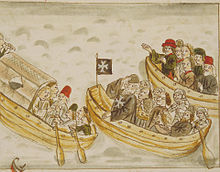Johann Loesel


Johann Loesel (* around 1390 ; † April 8, 1460 ) was a knight of the Order of St. John . From 1440 to 1444 he was Großbailli and from 1445 to 1460 (Grand) Prior of the Order of Alemannia.
Life and career
Johann Loesel came from an episcopal Strasbourg ministerial family. According to the coat of arms on his tombstone, his mother was née Schwarber. The Schwarber family belonged to the Strasbourg patriciate. He is first proven as a simple brother in the Ordenshaus zu den Eichen (also Eichhof) near Weißenburg (today Wissembourg ). Presumably he stayed in Rhodes afterwards. In 1426 he was awarded the commander in Mainz . However, he did not officiate as commander of Mainz for the first time until 1429 and celebrated his tenth anniversary in office in 1439. It is therefore possible that the document from 1426 is incorrectly dated, or he could not actually take possession of the coming one until 1429. In 1434 he was also commander of Rheinfelden . In 1440 he was appointed Großbailli in Rhodes , an office that had only been created in 1428 for the German tongue of the Order of St. John. A pilgrim ship had taken him and the Johanniter commendators Walter von Bussnang , Johannes von Schwalbach and Hans von Benfeld (?) To Rhodes. The Großbailli was responsible for the fortifications of Rhodes. During this time Johann Loesel stayed safely in Rhodes. For the Kommende Mainz it is documented at least for 1437 that a conductor there stood in for the Kommendator. When he was appointed Grand Prior of Germany in 1444, he resigned the office of Großbailli and probably also the Kommende Mainz. For this he administered since 1445 he the commander of Basel , Bubikon , Leuggern -Klingnau and Wädenswil ; he mostly resided in Wädenswil. He resigned the Coming Bubikon as early as 1445/46. Johann Wittich was already registered there as a (new) commander in November 1446. In February 1446 he initiated peace talks from boat to boat on Lake Zurich between the warring Confederates and the imperial city of Zurich. This scene is documented in a drawing by the Zurich chronicler Gerold Edlibach . However, it was not until June 12, 1446 that an armistice was reached. It took another four years until the settlement in the Kappel monastery (April 8, 1450) or the final arbitration proceedings in Einsiedeln (July 13, 1450). On July 4, 1450, Loesel renewed the castle rights with what was then the imperial city of Zurich.
In contrast to the coming Mainz, Johann Loesel seems to have kept the coming Rheinfelden. In 1449 Hans von Rechberg attacked the city of Rheinfelden and also destroyed the order house of the Johanniter, which was located in front of the city walls. In 1455 he was in Vienna with Archduke Albrecht of Austria and received permission from him to rebuild the religious house within the city. In 1456 he was personally in Rheinfelden and inspected the building site or determined the location for the new chapel. In the same year the chaplain of the Johanniter bought a barn next to the area of the Johanniterhaus on his behalf. In 1459 he is still documented as commander of Rheinfelden. It is possible that he also donated the high altar in the newly built Johanniter Chapel in Rheinfelden. His coat of arms, a cut angle pointing upwards, is attached to the sacrament house and the base of the statue of John on the western front of the Chapel of St. John.
In 1456 he took out a loan of 800 guilders from the keepers and governors of the Ballei der Oberer Land. He had the church rebuilt in Wädenswil and the rood screen built. His coat of arms is placed in the keystone.
Johannes Loesel probably died in Basel on April 8, 1460 and was buried in the now defunct St. John's Church in Basel. Its epitaph is lost, but a drawing of it still exists.
literature
- Walter Gerd Rödel: The German (grand) priors. In: Bernard Andenmatten (editing), Petra Zimmer and Patrick Braun (editing): Helvetia Sacra, 4th department, volume 7, part 1 The Johanniter. Pp. 51–76, Schwabe Verlag, Basel, 2006, p. 60.
Individual evidence
- ^ A. Bernoulli: Hans and Peter Rots Pilgerreisen, 1440 and 1453. Contributions to the history of Basel, 11: 329-408, Basel, 1882, p. 388.
- ↑ Gerold Edlibach: Zurich Chronicle. 279 S., Meyer and Zeller, 1847 Online at Google Books
- ↑ Veronika Feller-Vest: Wädenswil. In: Bernard Andenmatten (arrangement), Petra Zimmer and Patrick Braun (ed.): Helvetia Sacra, 4th department, volume 7, part 1 Die Johanniter, p. 514536, Schwabe Verlag, Basel, 2006
- ^ Cécile Sommer-Ramer: Rheinfelden. In: Bernard Andenmatten (arrangement), Petra Zimmer and Patrick Braun (ed.): Helvetia Sacra, 4th department, volume 7, part 1 Die Johanniter, pp. 416–442, Schwabe Verlag, Basel, 2006, p. 434 / 35
| predecessor | Office | successor |
|---|---|---|
| Hugo of Montfort-Bregenz |
Grand Prior of the German Order of St. John 1445–1464 |
Johann Schlegelholz |
| Johann Schlegelholz |
Großbailli of the Order of St. John 1440–1444 |
Johannes von Weitingen |
| personal data | |
|---|---|
| SURNAME | Loesel, Johann |
| BRIEF DESCRIPTION | Grand Prior |
| DATE OF BIRTH | around 1390 |
| DATE OF DEATH | April 8, 1460 |
